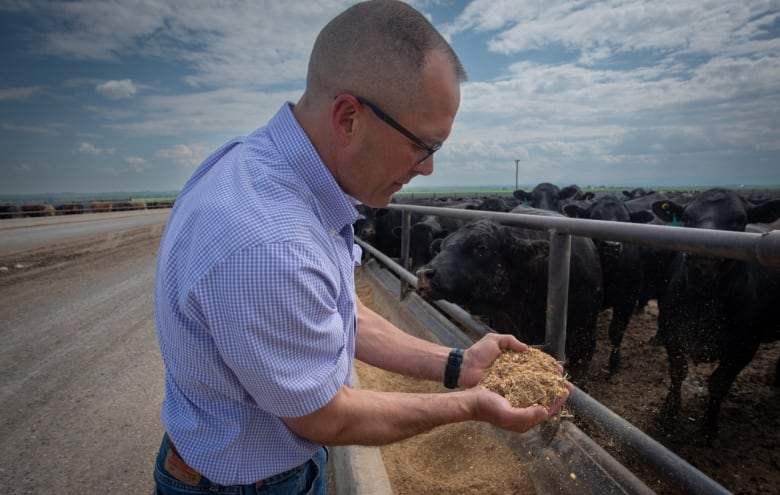
[ad_1]
It’s a mix that’s changed over time to improve herd health.
But now, innovators are looking at how changes to feed could also help to reduce methane emissions caused by cow burps.
“I think it represents an opportunity for farmers and consumers,” said Karen Beauchemin, an honorary research affiliate with Agriculture Canada in Lethbridge.
“We could reduce, in the future, the amount of methane being put into the atmosphere from our livestock.”
Cows carry a bacteria in their stomachs that helps to break down fibrous plant material, but they also produce methane as a byproduct, which is belched out into the atmosphere.
Roughly a third of all greenhouse gas emissions from the agricultural sector come from the digestive activities of cattle. That’s more than three per cent of Canada’s overall GHG emissions.
Producers are already making changes to help lower their contribution, but faster and more effective change will be needed in order for Canada to meet its goal of reducing methane emissions by at least 30 per cent below 2020 levels by 2030.
One of the most promising solutions, according to industry experts, is food additives.
And feedlots in Alberta are the easiest place to start using them, according to Dr. Calvin Booker, a veterinarian with Feedlot Health Management Services, a consulting service based in Okotoks, Alta.
“We are feeding the animals a diet that we prepare every day,” he said. “Of all feedlot production in Canada, 70 per cent happens here in Alberta.”

Some studies have already begun, while others are in planning. At least one additive, three-nitrooxypropanol, or 3-NOP, is showing between 25 and 80 per cent reductions in methane emissions.
“There’s no doubt that the effects on methane production are real. They’re repeatable and they’re profound,” said Booker.
Blocking methane
Additives like 3-NOP act as a methane inhibitor. It mimics another molecule in the digestive process, replacing it and blocking methane from being produced.
Beauchemin has studied the chemical for almost a decade as part of a research consortium.
“We’re feeding different doses to cattle in different diets and measuring methane emissions along with feed intake and weight gain,” she said.
“What we found was enteric methane — so that’s methane produced by the animal and breathed out through the mouth and the nose — was reduced on average about 30 per cent.”
To test the results further, Booker was brought in to scale up the research, which eventually involved 15,000 cattle at a feedlot over two years.

“No. 1 is animal health and welfare … and to make sure that the use of a feed additive like 3-NOP isn’t going to have any negative effects,” he said.
“We need to understand how it fits into the overall sustainability because environmental sustainability is only one aspect of overall sustainability. There has to be an economic sustainability from something and obviously there has to be an ethical one as well.”
The cost of the additive is also a bit of a mystery.
3-NOP is in use in the European Union, Chile and Brazil, where it’s considered a food additive. Canada and the United States are treating it like a drug, which requires a much more rigorous and time-consuming approval process.
The bigger challenge, for now, is figuring out what will spur cattle producers to actually use the chemical when it’s readily available.
Even if it’s found to have no negative effects, 3-NOP is unlikely to impact feed efficiency, Booker said. That means farmers likely won’t produce more meat by using it.
Instead, he says, some form of carbon credit may spur interest.
“There are protocols in place where producers … would be able to claim offsets and put those through the regulated emissions market here in Alberta, and there would be a dollar value associated with that,” Booker said.
Other innovations
3-NOP is not the only innovation on the horizon that Alberta cattle producers have to look forward to.
Elena Vinco is a researcher and policy analyst with the Simpson Centre at the School of Public Policy at the University of Calgary. She co-authored a paper published in April about near-term methane reduction options in the Alberta beef and dairy industry.
One of those is 3-NOP, but there’s also a food additive derived from tropical red seaweed.
“There’s a few different types in terms of species, but they all seem to demonstrate a pretty consistent methane reduction potential,” she said.
“We wanted to really narrow down on what was implementable in Alberta and Western Canada, as well as what is implementable in the short term.”
Another short-term solution researchers hear often is “eat less red meat.” But Beauchemin says that’s not as simple as it sounds, both in terms of environmental consequences and impacts to the food chain.
“I’m not saying that can’t be part of the equation, but there can be unintended consequences. And they’re not always obvious to consumers.”
Vinco is hopeful that with some innovation, Alberta cattle producers will be able to lead the way in reducing agricultural methane emissions in the country.
“I think that a lot of the burden, maybe unfairly, is being put on farmers, who truly are just doing the best that they can,” she said. “They really do prioritize sustainable practices.”
[ad_2]

التعليقات